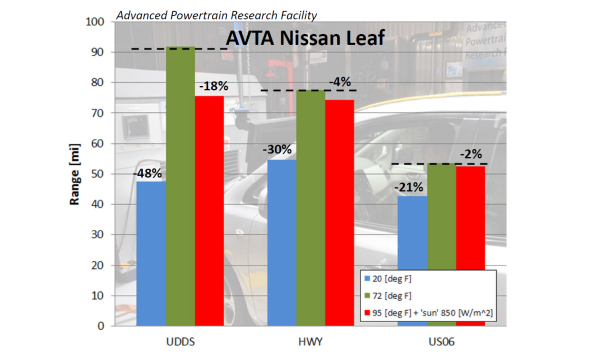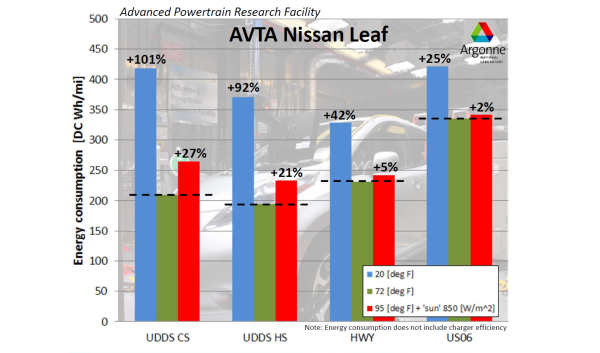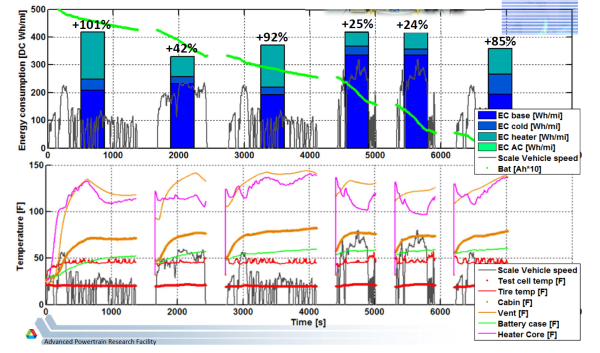The Tesla Model S Controversy: Understanding the Effects of Temperature on Electric Vehicle Efficiency and Range
by Vivek Gowri on February 18, 2013 4:22 PM EST- Posted in
- Auto
- Electric Vehicles
- Tesla Model S
- Nissan Leaf
Thermal Effects on Energy Consumption and Range
Looking at energy consumption, right off the bat, we can see that cold weather has a significant impact on EC - nearly double in urban driving, 40% more in the highway cycle, and 25% on the US06. It’s worth noting here: the Leaf has an 80 kW electric motor, a 24 kWh battery, and a 5 kW resistive heating element.
When broken down further, into a base load case (driving cycle EC at 72F), the amount of extra energy needed to drive the cycle at 20F (listed as EC cold), and then the heater load required to maintain a cabin temperature of 72F, we can see that a significant portion of the additional energy consumption is down to the heater. As with most gasoline cars, driving in sub-freezing temperatures only makes the car about 10% less efficient before heater loads are considered. The mechanically-driven heating elements in conventional vehicles add another 5% or so in terms of mechanical efficiency loss, while obviously the electric heater in the EV is far more costly from an energy consumption standpoint even though it doesn’t increase mechanical losses at all.
(Note: graphs were created by ANL using the raw 10Hz data instead of the filtered 1Hz data available on D3. Available as part of APRF's AVTA Nissan Leaf testing analysis and summary, as presented by Dr. Henning Lohse-Busch. Full presentation available here.)
And while energy consumption is a big deal, range is the be-all, end-all concern for most consumers. With the heater on, that’s a decrease in range by anywhere from 20-50% depending on your drive cycle. That’s a lot. And you can just look at the APRF’s full charge tests at 20F and 72F to see what I mean:
 Think about that - this is a car that, at launch, Nissan claimed had a 100 mile range. My own real-world driving suggests 80-85 a decent estimate. EPA says that number is closer to 73. The APRF’s instrumented testing backs that up (74.1 mile range at 72F), but the same instrumented testing, in 20F weather? 46 miles. That’s it.
Think about that - this is a car that, at launch, Nissan claimed had a 100 mile range. My own real-world driving suggests 80-85 a decent estimate. EPA says that number is closer to 73. The APRF’s instrumented testing backs that up (74.1 mile range at 72F), but the same instrumented testing, in 20F weather? 46 miles. That’s it.













102 Comments
View All Comments
Kjella - Monday, February 18, 2013 - link
"After all, limited gas stations didn't hamper the adoption of gas-fueled cars a century ago."That's a rather unfair comparison since it's trivial to bring extra gas with you in a can or a barrel, while there's no easy or cheap way to extend your battery range.
guidryp - Monday, February 18, 2013 - link
"Plug in hybrids make a lot more sense. "Not to me it doesn't, though I understand the initial appeal of the argument.
If I am going for a plug-in I am getting rid of the ICE components. With a PHEV, you are essentially always carrying dead weight. You are running in gas mode, pulling around a huge heavy battery of little use, or you are running in EV mode, pulling around huge heavy ICE components you aren't using, and you have the expense of the battery and the maintenance of an ICE car.
Most households are multi-car anyway. Have one pure ICE car, and one pure EV. Each of those is simpler and better suited to it's main role.
Even without a second car, the only time I drive more than 100 miles is on vacation. I could simply rent a car for that (and have many times even though I own an ICE car).
happycamperjack - Monday, February 18, 2013 - link
Thanks for the comment. I definitely think there's a market for pure EV, but for majority of the population, I just don't think they want deal with the chores that come with it especially when it's costing more and unproven in reliability. At least with plug ins, you have less things to worry about, but even that is too much to handle for a lot of the people.As for the dead weight argument, I agree,.I really think there should be more research on combining these two things together to save weight and space. Toyota did a good job with prius. I think they are the prime candidate for designing a new generation of plug ins engines that can be accepted by public.
phoenix_rizzen - Monday, February 18, 2013 - link
Or, go for the best of both worlds: a tiny, RPM-optimised diesel generator that does nothing but charge the batteries. Doesn't touch the drivetrain in any way. The Volt went about halfway down this path, but went with a gasoline engine that touches the drivetrain in certain circumstances.Diesels can be better optimised to always run "in the sweet spot" to get the most bang-for-the-buck. And, if its only used to charge the batteries, you only have to worry about a single drivetrain. Treat it like a pure-EV vehicle, since (in essence) that's what it is. You're just carrying around a very small generator for those longer trips.
Making it a plugin would just be icing.
beginner99 - Tuesday, February 19, 2013 - link
Well said. EVs just require to many compromises. Adjust driving style? Seriously? Then the charging. If you own a house and can just easily install such a station ok but at least were I live most people rent and a fix parking spot is often not included. And even if it is you will still need the go-ahead from the owner before you can install anything which by itself is not easy (the power must obviously be taken in such a way that it adds to your "power usage meter").If you can't charge at home it's a no go.
The only real solution are fuel cells. You have a smaller battery than these current EVs which is constantly charged by a fuel cell. Hence you don't have the downside of the fuel cell (eg. no peak output) and gain range. The small battery should be standardized (haha, i know not going to happen) for easy change.
Another alternative would be an additional, standardized, switchable battery. Instead of fueling or charging you just switch the battery at the "gas station". But I guess with current tech batteries in a size that make this work would just not have big enough mileage. But still adding 20 miles might make the difference. And larger cars (= more space) could have more of them.
But yeah, current tech has evolved over 100 years, it is so much better, its impossible to come up with something new that is just as good and convenient.
guidryp - Monday, February 18, 2013 - link
Once you learn the car better, you can get more out of it even in the coldOne Canadian Tested his Leaf at -13c after a 4 hour cold soak:
http://canadianleaf.wordpress.com/2012/02/14/extre...
By backing off on cabin heating, and using the heated seats/steering wheel, you can save power.
He went 125 kms (~78miles). Mind you this is mostly city driving. Highway eats power more, but it is also shorter in duration, so less energy is spent on heating the driver/mile.
Definitely you don't buy an EV if your round trip commute is on the edge of your range, you want a healthy cushion and bigger cushion if you live where it gets very cold. And you certainly don't forgo a complete charge before an overnight trip in an EV.
Midwayman - Monday, February 18, 2013 - link
I'd be interested to see data on the -20 test without the heater running. How much of that load is just electric heat, and how much is the battery capacity being diminished by cold? For example if you made an electric car with a propane heater what sort of range increase could you expect?bobbozzo - Monday, February 18, 2013 - link
It was 20F, not -20F.The hyphen/dash on the first page is confusing and should be changed to a colon.
AVonGauss - Monday, February 18, 2013 - link
While I agree that non-traditional automotive review methods need to be reconsidered, I think there is one take away from New York times article and that is the estimated range accuracy. We've all probably experienced it in laptops, where you have 1:41 minutes remaining that an hour later suddenly becomes 5 mins remaining. While using a device like a laptop or tablet that may be acceptable, the importance of the estimate accuracy is higher when using a motor vehicle. This is one case where you definitely want to be extremely conservative, even it makes your product seem a little less appealing at first glance.sweenish - Tuesday, February 19, 2013 - link
As far as I understood it, the car was fairly accurate in telling the NYT guy when it would die (the car told him it wouldn't make it close to the next charging station). He just decided to act surprised when it did die.